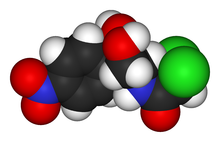 | |
 | |
| Clinical data | |
|---|---|
| Trade names | Pentamycetin, Chloromycetin, others [1] |
| AHFS/ Drugs.com | Monograph |
| MedlinePlus | a608008 |
| License data |
|
|
Pregnancy category |
|
|
Routes of administration | Eye drops, by mouth, IV, IM |
| Drug class | Antibiotic |
| Legal status | |
| Legal status | |
| Pharmacokinetic data | |
| Bioavailability | 75–90% |
| Protein binding | 60% |
| Metabolism | Liver |
| Elimination half-life | 1.6–3.3 hours |
| Excretion | Kidney (5–15%), faeces (4%) |
| Identifiers | |
| |
| Chemical and physical data | |
| Formula | C11H12Cl2N2O5 |
| Molar mass | 323.13 g·mol−1 |
| 3D model ( JSmol) | |
| |
| |
| (verify) | |
Chloramphenicol is an antibiotic useful for the treatment of a number of bacterial infections. [3] This includes use as an eye ointment to treat conjunctivitis. [5] By mouth or by injection into a vein, it is used to treat meningitis, plague, cholera, and typhoid fever. [3] Its use by mouth or by injection is only recommended when safer antibiotics cannot be used. [3] Monitoring both blood levels of the medication and blood cell levels every two days is recommended during treatment. [3]
Common side effects include nausea, and diarrhea. [3] Rarely bone marrow suppression may occur which may result in death. [6] [3] To reduce the risk of side effects treatment duration should be as short as possible. [3] People with liver or kidney problems may need lower doses. [3] In young children a condition known as gray baby syndrome may occur which results in a swollen stomach and low blood pressure. [3] Its use near the end of pregnancy and during breastfeeding is typically not recommended. [7] Chloramphenicol is a broad-spectrum antibiotic that typically stops bacterial growth by stopping the production of proteins. [3]
Chloramphenicol was discovered after being isolated from Streptomyces venezuelae in 1947. [8] Its chemical structure was identified and it was first artificially made in 1949, making it the first antibiotic to be made instead of extracted from a micro-organism. [8]: 26 It is on the World Health Organization's List of Essential Medicines. [9] It is available as a generic medication. [3] The wholesale cost in the developing world of an intravenous dose is about US$0.40–1.90. [10] In the United States an intravenous dose costs about $41.47. [11]
References
- ^ Woods, Adrienne L. (2008). Delmar nurse's drug handbook (2009 ed.). Clifton Park, N.Y.: Delmar. p. 296. ISBN 9781428361065. Archived from the original on 2016-03-05.
- ^ "Chloramphenicol". PubChem. Archived from the original on 2016-11-15.
- ^ a b c d e f g h i j k l m "Chloramphenicol". The American Society of Health-System Pharmacists. Archived from the original on 2015-06-24. Retrieved Aug 1, 2015.
-
^ Cite error: The named reference
WHO2020DDDwas invoked but never defined (see the help page). - ^ Edwards, Keith H. (2009). Optometry: Science, Techniques and Clinical Management. Elsevier Health Sciences. p. 102. ISBN 978-0750687782. Archived from the original on 2017-03-07.
- ^ Ritter, James M.; Flower, Rod; Henderson, Graeme; Loke, Yoon Kong; Robinson, Emma; Fullerton, James (2024). "52. Antibacterial drugs". Rang & Dale's Pharmacology (10th ed.). Elsevier. p. 712. ISBN 978-0-7020-7448-6. Archived from the original on 2024-02-10. Retrieved 2024-01-30.
- ^ "Chloramphenicol Pregnancy and Breastfeeding Warnings". Multum Information Services. Archived from the original on 8 September 2015. Retrieved 26 August 2015.
- ^ a b Pongs, O. (1979). "Chapter 3: Chloramphenicol". In Hahn, eFred E. (ed.). Mechanism of Action of Antibacterial Agents. Antibiotics Volume V Part 1. Berlin, Heidelberg: Springer Berlin Heidelberg. pp. 26–42. ISBN 978-3-642-46403-4.
- ^ World Health Organization (2019). World Health Organization model list of essential medicines: 21st list 2019. Geneva: World Health Organization. hdl: 10665/325771. WHO/MVP/EMP/IAU/2019.06. License: CC BY-NC-SA 3.0 IGO.
- ^ "Chloramphenicol". International Drug Price Indicator Guide. Archived from the original on 22 November 2018. Retrieved 26 August 2015.
- ^ "Chloramphenicol Prices, Coupons & Patient Assistance Programs - Drugs.com". Drugs.com. Archived from the original on 2017-03-08.
 | |
 | |
| Clinical data | |
|---|---|
| Trade names | Pentamycetin, Chloromycetin, others [1] |
| AHFS/ Drugs.com | Monograph |
| MedlinePlus | a608008 |
| License data |
|
|
Pregnancy category |
|
|
Routes of administration | Eye drops, by mouth, IV, IM |
| Drug class | Antibiotic |
| Legal status | |
| Legal status | |
| Pharmacokinetic data | |
| Bioavailability | 75–90% |
| Protein binding | 60% |
| Metabolism | Liver |
| Elimination half-life | 1.6–3.3 hours |
| Excretion | Kidney (5–15%), faeces (4%) |
| Identifiers | |
| |
| Chemical and physical data | |
| Formula | C11H12Cl2N2O5 |
| Molar mass | 323.13 g·mol−1 |
| 3D model ( JSmol) | |
| |
| |
| (verify) | |
Chloramphenicol is an antibiotic useful for the treatment of a number of bacterial infections. [3] This includes use as an eye ointment to treat conjunctivitis. [5] By mouth or by injection into a vein, it is used to treat meningitis, plague, cholera, and typhoid fever. [3] Its use by mouth or by injection is only recommended when safer antibiotics cannot be used. [3] Monitoring both blood levels of the medication and blood cell levels every two days is recommended during treatment. [3]
Common side effects include nausea, and diarrhea. [3] Rarely bone marrow suppression may occur which may result in death. [6] [3] To reduce the risk of side effects treatment duration should be as short as possible. [3] People with liver or kidney problems may need lower doses. [3] In young children a condition known as gray baby syndrome may occur which results in a swollen stomach and low blood pressure. [3] Its use near the end of pregnancy and during breastfeeding is typically not recommended. [7] Chloramphenicol is a broad-spectrum antibiotic that typically stops bacterial growth by stopping the production of proteins. [3]
Chloramphenicol was discovered after being isolated from Streptomyces venezuelae in 1947. [8] Its chemical structure was identified and it was first artificially made in 1949, making it the first antibiotic to be made instead of extracted from a micro-organism. [8]: 26 It is on the World Health Organization's List of Essential Medicines. [9] It is available as a generic medication. [3] The wholesale cost in the developing world of an intravenous dose is about US$0.40–1.90. [10] In the United States an intravenous dose costs about $41.47. [11]
References
- ^ Woods, Adrienne L. (2008). Delmar nurse's drug handbook (2009 ed.). Clifton Park, N.Y.: Delmar. p. 296. ISBN 9781428361065. Archived from the original on 2016-03-05.
- ^ "Chloramphenicol". PubChem. Archived from the original on 2016-11-15.
- ^ a b c d e f g h i j k l m "Chloramphenicol". The American Society of Health-System Pharmacists. Archived from the original on 2015-06-24. Retrieved Aug 1, 2015.
-
^ Cite error: The named reference
WHO2020DDDwas invoked but never defined (see the help page). - ^ Edwards, Keith H. (2009). Optometry: Science, Techniques and Clinical Management. Elsevier Health Sciences. p. 102. ISBN 978-0750687782. Archived from the original on 2017-03-07.
- ^ Ritter, James M.; Flower, Rod; Henderson, Graeme; Loke, Yoon Kong; Robinson, Emma; Fullerton, James (2024). "52. Antibacterial drugs". Rang & Dale's Pharmacology (10th ed.). Elsevier. p. 712. ISBN 978-0-7020-7448-6. Archived from the original on 2024-02-10. Retrieved 2024-01-30.
- ^ "Chloramphenicol Pregnancy and Breastfeeding Warnings". Multum Information Services. Archived from the original on 8 September 2015. Retrieved 26 August 2015.
- ^ a b Pongs, O. (1979). "Chapter 3: Chloramphenicol". In Hahn, eFred E. (ed.). Mechanism of Action of Antibacterial Agents. Antibiotics Volume V Part 1. Berlin, Heidelberg: Springer Berlin Heidelberg. pp. 26–42. ISBN 978-3-642-46403-4.
- ^ World Health Organization (2019). World Health Organization model list of essential medicines: 21st list 2019. Geneva: World Health Organization. hdl: 10665/325771. WHO/MVP/EMP/IAU/2019.06. License: CC BY-NC-SA 3.0 IGO.
- ^ "Chloramphenicol". International Drug Price Indicator Guide. Archived from the original on 22 November 2018. Retrieved 26 August 2015.
- ^ "Chloramphenicol Prices, Coupons & Patient Assistance Programs - Drugs.com". Drugs.com. Archived from the original on 2017-03-08.